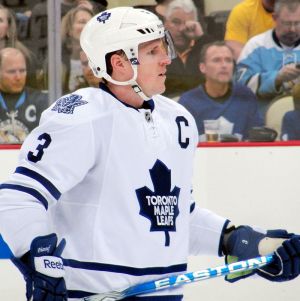I was watching hockey a few nights when I heard NBC’s Pierre McGuire describe a rookie defenseman in glowing terms. It was the same kind of praise he used to shower upon Dion Phaneuf about 10 years ago, and this young player had very similar attributes to an early-20s Phaneuf: a huge frame, a huge slapshot, and a willingness to use both in equal measures.
McGuire made this player out to be a future superstar in the NHL, which was an alarming thought considering how people in the hockey world had misread the professional prospects of big-bodied defensemen such as Phaneuf, Ryan Whitney, Cam Barker and countless others in the past decades.
Now, this is not to say that McGuire and everyone else are blind or stupid – I just happen to think they are looking for the wrong things, in the wrong places. And it’s hard to fault them.
Fans and media love a guy who can dish out big hits and big one-timers. For them, hockey is entertainment, and those kinds of plays are some of the most entertaining things about our great sport.
Coaches and GMs want guys who block shots, don’t turn the puck over and can play good D-zone coverage. That makes sense because their focus is on having people who can make sacrifices in the name of the team, manage risk, and prevent the opponents from creating high-quality scoring chances.
But those things do not matter to me nearly as much as two other things, which I believe to be integral to a defenseman’s job requirement:
- The ability to support the puck across the two blue lines
- The ability to prevent the opposition from supporting the puck across the two blue lines
Before we get to the big shot from the point, we need to move the puck from the D zone to the O zone. P.K. Subban would still be a fantastic first-pairing defender even if he chose to never take a slap shot ever again. Jake Gardiner, Anton Stralman and Mark Giordano have shown strong aptitudes for controlling transitional play for their teams, and it’s reflected in the trio’s respective possession ratings. Cody Franson and Patrick Wiercioch, despite having obvious warts on other parts of their games, are terrific at helping their teammates generate offense and suppress controlled entries against. Marc-Edouard Vlasic, Paul Martin and Matt Niskanen do great in these measures despite not having all-world physical or technical attributes.
On the flipside, you have guys such as Phaneuf, Alexei Emelin, Rob Scuderi, Dennis Wideman and even Shea Weber, who do a ton of things right in the offensive and defensive zones, but consistently put their teams at a disadvantage across the blue lines when they are on the ice. They could be sub-par at creating controlled breakouts, preventing controlled entries or pinching to sustain the attack in the O zone, or a combination of those things. Regardless of the specifics, all of that eventually leads to a negative shot differential, a negative goal differential, and, further down the road, a negative win differential.
***
Jack Han is the Video & Analytics Coordinator for the McGill Martlet Hockey team. He also writes occasionally about the NHL for Habs Eyes on the Prize. You can find him on Twitter or on the ice at McConnell Arena.


Are there new metrics to show this, or do the existing advanced stats numbers support this view? It would be interesting to see what ones you’ve used here. I think a lot of people would be surprised to see Weber in the second group, as many view him among the top 5 defensemen in the NHL. Would love to see how Team Canada’s D-corps for the last Olympic games fare against each other. I’m a Habs fan, so wanted to see PK playing ahead of a number of guys on the team, and suspect a thorough evaluation of d-men would prove he was worthy of being in the top half of that group. It would make for an interesting article, hint, hint.
That’s where you get into the kind of stuff people pay me to do. But yes, there are different things to look at there.
There were some legitimate reasons why P.K. didn’t play at lot at the Olympics, but Team Canada was stacked on defense anyway.